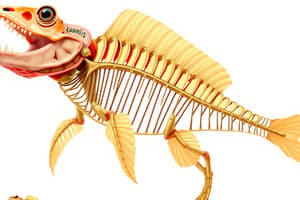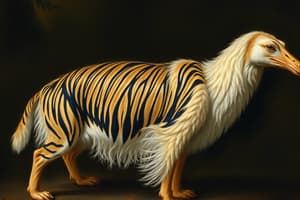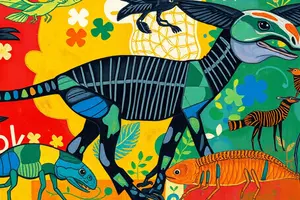Podcast
Questions and Answers
Vertebrates constitute approximately what percentage of overall animal biodiversity?
Vertebrates constitute approximately what percentage of overall animal biodiversity?
- 50%
- 75%
- 25%
- 5% (correct)
Which characteristic is common to all vertebrates?
Which characteristic is common to all vertebrates?
- Lack of symmetry
- Cartilaginous skeleton
- External skeleton
- Internal skeleton with a spine (correct)
How does the circulatory system of fish differ from that of terrestrial vertebrates?
How does the circulatory system of fish differ from that of terrestrial vertebrates?
- Fish have an open circulatory system.
- Terrestrial vertebrates lack blood vessels.
- Terrestrial vertebrates have a single-circuit system.
- Fish have a single-circuit system. (correct)
Which of the following is a key adaptation that allows reptiles to lay eggs on land?
Which of the following is a key adaptation that allows reptiles to lay eggs on land?
What feature distinguishes cartilaginous fish from bony fish?
What feature distinguishes cartilaginous fish from bony fish?
What adaptation do fish have to detect movement in the water?
What adaptation do fish have to detect movement in the water?
The term 'amphibian' refers to the...
The term 'amphibian' refers to the...
How do adult amphibians primarily breathe?
How do adult amphibians primarily breathe?
What unique structure enables birds to produce a wide variety of songs?
What unique structure enables birds to produce a wide variety of songs?
Which of the following describes the function of the crop in birds?
Which of the following describes the function of the crop in birds?
What is the primary function of hair in mammals?
What is the primary function of hair in mammals?
What is the role of the placenta in placental mammals?
What is the role of the placenta in placental mammals?
Unlike other mammals, monotremes...
Unlike other mammals, monotremes...
What is the marsupium?
What is the marsupium?
Reptiles, fish, and amphibians are all...
Reptiles, fish, and amphibians are all...
Flashcards
Vertebrates
Vertebrates
Animals in the Chordata phylum, includes Mammals, Birds, Reptiles, Amphibians, Fish.
Vertebrate Skeleton
Vertebrate Skeleton
Internal articulated bones that support the body, forming the spine, limbs, or fins.
Vertebrate Digestive System
Vertebrate Digestive System
A digestive system that helps vertebrates process nutrients from foods and includes the digestive tract, liver, and pancreas.
Vertebrate Circulatory System
Vertebrate Circulatory System
Signup and view all the flashcards
Vertebrate Kidneys
Vertebrate Kidneys
Signup and view all the flashcards
Vertebrate Nervous System
Vertebrate Nervous System
Signup and view all the flashcards
Vertebrate Reproduction
Vertebrate Reproduction
Signup and view all the flashcards
Fish
Fish
Signup and view all the flashcards
Ectotherms
Ectotherms
Signup and view all the flashcards
Operculum
Operculum
Signup and view all the flashcards
How Fish Breathe
How Fish Breathe
Signup and view all the flashcards
Fish Lateral Line
Fish Lateral Line
Signup and view all the flashcards
Amphibians
Amphibians
Signup and view all the flashcards
What Adult use to Breathe?
What Adult use to Breathe?
Signup and view all the flashcards
Amphibian Reproduction
Amphibian Reproduction
Signup and view all the flashcards
Study Notes
- Study notes on Vertebrates
Vertebrates Overview
- Vertebrates are the largest group of animals within the Chordata phylum
- They are familiar animals but constitute about 5% of animal biodiversity.
- Vertebrates are classified into five types: mammals, birds, reptiles, amphibians, and fish
Mammals
- Most mammals are terrestrial
- They produce milk to feed their young
Birds
- Birds are terrestrial animals
- Birds have wings and feathers
Reptiles
- Reptiles are mainly terrestrial
- Reptiles have short or no legs
Amphibians
- They start life in the water
- Later they continue life on land
Fish
- Fish are aquatic animals
- Fish have long bodies and fins
Characteristics of Vertebrates
- Vertebrates possess an internal skeleton made of articulated bones
- The spine or backbone acts as the axis, with articulated limbs (legs, wings, or fins)
- They exhibit bilateral symmetry
- Their bodies are covered with skin, featuring insulating structures such as scales, feathers, or hair
- They also have protective structures like claws or horns
- Vertebrates have a digestive system comprising the digestive tract and glands like the liver and pancreas
- They possess a closed circulatory system with a heart and blood vessels, and their blood contains red blood cells
- Aquatic vertebrates respire through gills, while terrestrial vertebrates breathe through lungs
- The kidneys serve as the main organs of the excretory system, filtering the blood
- The head houses the brain and various sensory organs
- The spinal cord runs along the back, protected by the spine
- Nerves connect the brain and spinal cord to all organs in the body
- Vertebrates reproduce sexually, with distinct male and female sexes
- Fertilization is external in aquatic animals, and internal in terrestrial animals
- They can be oviparous (lay eggs), viviparous (give birth to live young), or ovoviviparous (eggs hatch inside the female)
- Ovoviviparous means the eggs remain inside the female until the young develop, then hatch inside her body
Fish Characteristics
- Fish are aquatic animals in fresh and saltwater
- They are a food source for humans
- The fishing industry is economically important
Characteristics of Fish
- Their body temperature matches their environment
- Fish have a long body which reduces water resistance for swimming
- Their skin is covered in scales
- They use pairs of pectoral and pelvic fins
- They have single fins along the midline
- The operculum protects the gills
- The lateral line is a sense organ
Life Processes of Fish
- They breathe through gills
- Gills take in oxygen dissolved
- Water enters their mouth, passes through the gills, and is expelled
- Fish have a single circulatory system
- The heart pumps blood to the gills
- Blood absorbs oxygen and distributes it to the body
- Blood returns to the heart
- Fish have a lateral line to detects movement
- Fish can detect tiny electrical currents
- Fish can change sex during their life
- Most fish are oviparous with external fertilization
- Fish do not care for their young
Classification of Fish
- Cartilaginous fish have skeletons made of cartilage
- Their gills are exposed (without operculum)
- Mouths are on their ventral side
- They include sharks, rays, and manta rays
- Bony fish have skeletons made of bone
- They possess a swim bladder to control buoyancy
- Mouths are at the front end of the body
Amphibians Overview
- Amphibians spend initial life stages in water and adulthood on land
- Return to water for reproduction
- They are important for controlling insect populations on crops
- Their presence indicates a healthy ecosystem
- They face threats due to climate change
Amphibian Characteristics
- Ectothermic
- They can’t tolerate dry environments
- They have bare, moist skin
- Some have a tail
- They have four limbs with webbed toes for swimming
- They have a large mouth with teeth
- They have a long, slimy tongue to capture prey
- Some have glands for moistening skin
- Some produce toxic substances
Amphibian Life Processes
- Adults are carnivores; tadpoles are herbivores/omnivores
- Adults breathe through lungs which are sacs inside
- They can breathe their skin when in aquatic
- Larvae breathe through gills
- Possess 2 circulatory circuits
- Circuit 1 carries blood from the heart to the lungs
- Circuit 2 carries blood from the heart to the body
- Amphibians have three eyelids , and vocal cords to make sounds
- Most are oviparous and external fertilization
- Lay eggs in water
- Egg hatching turns into tadpoles
- Tadpoles go through metamorphosis into adult form
Classification of Amphibians
- Anura are frogs and toads and lack tails
- They have long hind legs adapted for jumping
- Urodela are salamanders and newts, with tails and long bodies and legs of same size
Reptiles Overview
- Most reptiles are terrestrial, with some exceptions like sea turtles
- Reptiles control rodent populations that carry diseases in cities
- Reptiles, along with amphibians, form the most threatened group of vertebrates
Reptile Characteristics
- They are ectothermic so their body temperature matches their environment
- They have waterproof skin covered in scales, preventing water loss
- Reptiles have a long, pointed tail
- Most have four short legs, while some have no legs and slither or crawl
Reptile Anatomy
- Some reptiles have large teeth, and others have a hard, horny beak
- Snakes and lizards will moult and shed their skin regularly
Reptile Life Processes
- Most reptiles are carnivorous and swallow prey whole
- Breathe through lungs
- Have a double circulatory system
- Kidneys produce urine with minimal water
- Fertilization is internal, and they are oviparous or ovoviviparous
- Reptile eggs have a covering that prevents water loss but allows air circulation
- Reptiles eggs can be laid on land
Classification of Reptiles
- Lizards: Include lizards, geckos, iguanas, and chameleons
- Many shed their tails to escape from predators
- Turtles: Can be terrestrial or aquatic and have a short, wide body covered in a bony shell
- They have a horny beak
- Snakes: have no limbs, may be venomous such as boas, pythons, cobras, and vipers
- Crocodiles: Have long snouts with numerous teeth and their tails are suited to swim. No European species
Birds Overview
- Birds are terrestrial animals that can fly, but some cannot fly
- They are a food source (meat and eggs)
- Their excrement is used as fertilizer
- They control agricultural pests, pollinate plants and disperse seeds
Characteristics of birds
- Birds are endotherms
- Feathers covering body, maintaining body temperature
- Aerodynamic shape facilitates flight
- They have four limbs, back ones with legs bearing four toed
- Wings are the front limbs
- They have thin and hollow bones for light needed for flight
- Mouth is modified into a beak which has no teeth
Bird Nutrition
- Lungs are connected to air sacs to function as air reserve and enable flight
- They have a double circulatory system
- Their digestive system contain a crop, a cavity where food is stored and softened before digestion, and a gizzard that stores small stones which help them with grinding food.
- The beak shape relates to each bird's diet with birds of prey possessing sharp, curved beaks, insect eaters having short, narrow beaks, and fish eaters having long, sharp, pointed beaks
Bird Senses and Migration
- Birds have highly developed eyesight with three eyelids and one transparent
- They have a syrinx organ located in the trachea that produce many songs and enables vocalization
- Their ability to fly help migrate to escape unfavourable conditions
Reproduction in Birds
- Oviparous
- Fertilization is internal
- Lay eggs in nests of differing complexity
- Birds incubate eggs by covering them with their bodies to keep them warm
- After hatching the parents care for their hatchlings In many species of birds both parents incubate and care for their chicks
Classification of birds
- Flightless birds which are cannot fly, and don't live in Europe
- Game birds which are poor fliers that includes roosters, turkeys, and pheasants
- Wading birds have long legs and beaks in the storks and herons families
- Water birds that are known for webbed feet that aid with swimming and a flat beak
- Diurnal birds of prey have strong beaks and talons and are the vultures and eagles families
- Nocturnal birds of prey have good eyesight and hearing helping to hunt in the night
- Gulls which are average seabirds for water
- Passerines which are a common and smaller group
Mammals Overview
- Mammals are a varied group adapted to diverse environments
- Food is obtained from mammals such as: meat, milk and wool
- Mammals are utilized for transport, farm work, experiments and are used for company
Mammals Characteristics
- Like birds, mammals are endotherms that have a consistent body temperature
- Usually have four limbs
- Insulating hair covering the body
- Glands will be in the skin; sweat and odor, and mammary glands that produce milk to suckle young
- Have toes with nails or claws
- Lips allow to suckle and they also have teeth
Mammal Nutrition
- Mammals respire oxygen in and out with a diaphragm.
- Mammals circulate double and have lungs
- Diet has a big variety; herbivores, carnivores and omnivores with various teeth variations.
Mammal Senses and Reproduction
- Mammals nervous system has the highest development
- Most use four legs for movement, while others are swimmers or flight.
- Most viviparous develop in uterus, with a placenta forming that supports the young with mothers care and milk is suckled.
Classification of Mammals
- Monotremes are unique oviparous that include only echidna and platypus
- Marsupials are viviparous and do not have a placenta, with young maturing inside their pouch
- Placentals constitute remainder of mammals and have a placenta.
Studying That Suits You
Use AI to generate personalized quizzes and flashcards to suit your learning preferences.




